Vertebrates - Animals with Backbones
Vertebrates are animals that possess a backbone or spinal column. This group includes a wide variety of animals, from fish and amphibians to reptiles, birds, and mammals. Vertebrates are characterized by the presence of a vertebral column, which provides support and protection for the spinal cord.
Characteristics of Vertebrates
Vertebrates share several key characteristics:
- Vertebral Column: The presence of a backbone made up of individual vertebrae.
- Internal Skeleton: Vertebrates have an internal skeleton made of bone or cartilage, providing structural support and protection for internal organs.
- Well-Developed Nervous System: Vertebrates have a well-developed brain and spinal cord, which form the central nervous system.
- Bilateral Symmetry: Most vertebrates exhibit bilateral symmetry, meaning their bodies can be divided into two similar halves.
- Advanced Respiratory Systems: Vertebrates typically have complex respiratory systems, including lungs or gills, to facilitate gas exchange.
Classification of Vertebrates
Vertebrates are classified into five main groups:
- Fish: This group includes a diverse range of aquatic vertebrates, with species such as sharks, bony fish, and rays.
- Amphibians: Amphibians are vertebrates that typically undergo metamorphosis, transitioning from aquatic larvae to terrestrial adults. Examples include frogs, toads, and salamanders.
- Reptiles: Reptiles are characterized by their scaly skin and typically lay shelled eggs. This group includes snakes, lizards, turtles, and crocodiles.
- Birds: Birds are warm-blooded vertebrates with feathers and beaks. They are adapted for flight and exhibit a wide range of behaviors and adaptations for various habitats.
- Mammals: Mammals are warm-blooded vertebrates that typically give birth to live young and nurse them with milk produced by mammary glands. This diverse group includes humans, whales, bats, and many other species.
Study Guide
Here are some key points to remember when studying vertebrates:
- What is the main characteristic that defines vertebrates?
- List the five main groups of vertebrates and provide an example of each.
- Describe the key features of the vertebral column and its function in vertebrates.
- Compare and contrast the respiratory systems of fish, amphibians, reptiles, birds, and mammals.
- Discuss the evolutionary adaptations that have allowed vertebrates to thrive in various environments.
Understanding vertebrates and their diverse adaptations can provide valuable insights into the natural world and the mechanisms of evolution that have shaped life on Earth.
.◂Science Worksheets and Study Guides Fourth Grade. Vertebrates - Animals with Backbones
Study Guide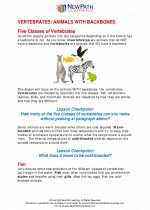 Vertebrates - Animals with Backbones
Vertebrates - Animals with Backbones  Activity Lesson
Activity Lesson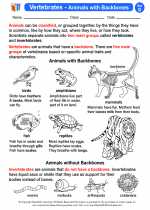 Vertebrates - Animals with Backbones
Vertebrates - Animals with Backbones  Worksheet/Answer key
Worksheet/Answer key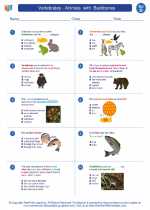 Vertebrates - Animals with Backbones
Vertebrates - Animals with Backbones  Worksheet/Answer key
Worksheet/Answer key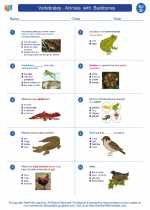 Vertebrates - Animals with Backbones
Vertebrates - Animals with Backbones  Worksheet/Answer key
Worksheet/Answer key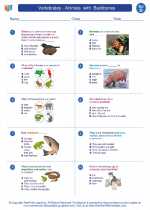 Vertebrates - Animals with Backbones
Vertebrates - Animals with Backbones  Worksheet/Answer key
Worksheet/Answer key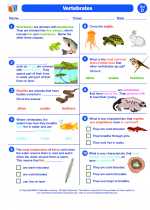 Vertebrates
Vertebrates  Vocabulary/Answer key
Vocabulary/Answer key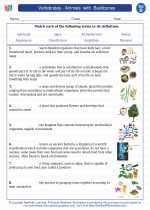 Vertebrates - Animals with Backbones
Vertebrates - Animals with Backbones  Vocabulary/Answer key
Vocabulary/Answer key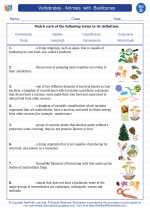 Vertebrates - Animals with Backbones
Vertebrates - Animals with Backbones  Vocabulary/Answer key
Vocabulary/Answer key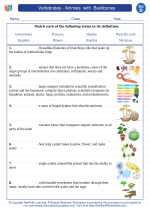 Vertebrates - Animals with Backbones
Vertebrates - Animals with Backbones  Vocabulary/Answer key
Vocabulary/Answer key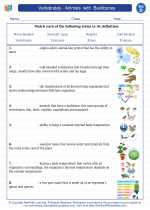 Vertebrates - Animals with Backbones
Vertebrates - Animals with Backbones 

 Activity Lesson
Activity Lesson
 Worksheet/Answer key
Worksheet/Answer key
 Worksheet/Answer key
Worksheet/Answer key
 Worksheet/Answer key
Worksheet/Answer key
 Worksheet/Answer key
Worksheet/Answer key
 Vocabulary/Answer key
Vocabulary/Answer key
 Vocabulary/Answer key
Vocabulary/Answer key
 Vocabulary/Answer key
Vocabulary/Answer key
 Vocabulary/Answer key
Vocabulary/Answer key

The resources above cover the following skills:
Life Science: The students will use scientific skills and processes to explain the dynamic nature of living things, their interactions, and the results from the interactions that occur over time.
Diversity of Life: Explain how animals and plants can be grouped according to observable features.
Classify a variety of animals and plants according to their observable features and provide reasons for placing them into different groups.